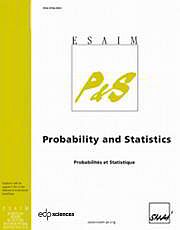Article contents
Limit theorems for some functionals with heavy tails of adiscrete time Markov chain
Published online by Cambridge University Press: 08 October 2014
Abstract
Consider an irreducible, aperiodic and positive recurrent discrete time Markov chain(Xn,n ≥0) with invariant distribution μ. We shall investigate thelong time behaviour of some functionals of the chain, in particular the additivefunctional \hbox{$S_{n}=\sum_{i=1}^{n}f(X_{i})$} Sn=∑i=1nf(Xi) for a possibly non square integrable functionf. To thisend we shall link ergodic properties of the chain to mixing properties, extending knownresults in the continuous time case. We will then use existing results of convergence tostable distributions, obtained in [M. Denker and A. Jakubowski, Stat. Probab.Lett. 8 (1989) 477–483; M. Tyran-Kaminska, StochasticProcess. Appl. 120 (2010) 1629–1650; D. Krizmanic, Ph.D. thesis(2010); B. Basrak, D. Krizmanic and J. Segers, Ann. Probab. 40(2012) 2008–2033] for stationary mixing sequences. Contrary to the usualL^2
Sn=∑i=1nf(Xi) for a possibly non square integrable functionf. To thisend we shall link ergodic properties of the chain to mixing properties, extending knownresults in the continuous time case. We will then use existing results of convergence tostable distributions, obtained in [M. Denker and A. Jakubowski, Stat. Probab.Lett. 8 (1989) 477–483; M. Tyran-Kaminska, StochasticProcess. Appl. 120 (2010) 1629–1650; D. Krizmanic, Ph.D. thesis(2010); B. Basrak, D. Krizmanic and J. Segers, Ann. Probab. 40(2012) 2008–2033] for stationary mixing sequences. Contrary to the usualL^2 L2 frameworkstudied in [P. Cattiaux, D. Chafai and A. Guillin, ALEA, Lat. Am. J. Probab. Math.Stat. 9 (2012) 337–382], where weak forms of ergodicity aresufficient to ensure the validity of the Central Limit Theorem, we will need here strongergodic properties: the existence of a spectral gap, hyperboundedness (orhypercontractivity). These properties are also discussed. Finally we give explicitexamples.
L2 frameworkstudied in [P. Cattiaux, D. Chafai and A. Guillin, ALEA, Lat. Am. J. Probab. Math.Stat. 9 (2012) 337–382], where weak forms of ergodicity aresufficient to ensure the validity of the Central Limit Theorem, we will need here strongergodic properties: the existence of a spectral gap, hyperboundedness (orhypercontractivity). These properties are also discussed. Finally we give explicitexamples.
Keywords
- Type
- Research Article
- Information
- Copyright
- © EDP Sciences, SMAI 2014
References
- 6
- Cited by


